Photo caption: The edible battery (center), surrounded by the ingredients used to make it (clockwise from top right): almonds, capers, edible gold foil, activated carbon, nori algae, water electrolyte, beeswax. Photo: G. Berretta / Istituto Italiano di Tecnologia – © IIT, all rights reserved.
Imagine a world where you can monitor your stomach or intestine’s health by simply ingesting a pill, or where you can check if your food is still fresh by communicating with a sensor embedded in it. Now, envision achieving all of this with electronics made from edible materials that your body can digest! The advent of edible electronics is set to revolutionize our lifestyles, but to make them truly functional, we need edible batteries to power them.
Powering Our Bodies and Devices
Electricity is the lifeblood of our modern society, driving everything from small gadgets to vehicles. Yet, few realize that our bodies also rely on miniature batteries to function. These batteries operate by molecules exchanging electrons, generating the energy needed to power our biological processes.
Discovering Edible Battery Components with Almonds
Researchers have discovered a pair of molecules suitable for creating edible batteries: riboflavin, commonly found in foods like almonds, serves as the electron donor, while quercetin, present in foods like capers and dried berries, acts as the electron acceptor. These molecules form the core of the battery, but to make it practical, we needed to incorporate conductive materials and insulators.
Assembling the Edible Battery
Activated carbon, known for its digestive benefits, was used to anchor riboflavin and quercetin, while edible gold foil, typically used for cake decorations, formed the wires. To prevent short circuits, nori algae, used in sushi rolls, was employed as a separator between the two battery sides. Finally, everything was encapsulated in beeswax to create a fully edible battery.
Driving Innovation with Sustainable Solutions
The mastermind behind this innovation is Ivan Ilic, whose expertise in electrochemistry and commitment to sustainable solutions drove the project forward. Collaborating with the Edible Electronics research team, led by Mario Caironi at the Istituto Italiano di Tecnologia, they are now expanding their efforts to develop other essential components for edible electronic systems, such as edible circuits, sensors, and communication strategies. Currently, their focus is on assembling prototypes of edible pills equipped with miniaturized batteries and circuits designed to monitor gastrointestinal health.
Dr. Mario Caironi is Senior Scientist at the Istituto Italiano di Tecnologia, where he leads the Printed and Molecular Electronics research line. An electronic engineer by training, he is currently the recipient of the European Research Council project Electronic Food (ELFO) on edible electronics.
Dr. Ivan Ilic studied chemistry in Croatia and Germany, earning his PhD while working at the Max Planck Institute on sustainable batteries. He led the development of the edible battery during his postdoc at Istituto Italiano di Tecnologia within the ELFO project.
For more information: Ilic, I. K., Galli, V., Lamanna, L., Cataldi, P., Pasquale, L., Annese, V. F., Athanassiou, A., & Caironi, M. (2023). An Edible Rechargeable Battery. Advanced Materials (Deerfield Beach, Fla.), 35(20), e2211400.







